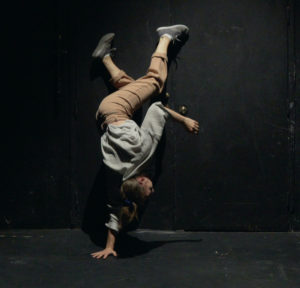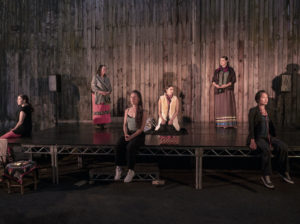Dancing on the Edge in Vancouver, the pandemic edition - Vancouver Ballet Society
- Home
- Reviews 2020 - 2023
- Dancing on the Edge in Vancouver, the pandemic edition

By Rachel Silver Maddock
Vancouver’s 32nd annual Dancing on the Edge Festival stepped boldly into the “new normal,” programming a combination of digital and live performances. The festival, based at the Firehall Arts Centre, presented over 20 works between July 2-11. Most were livestreams and screenings of dance films, but three works were presented at the Firehall, making the Edge one of the first in Vancouver to put dancers onstage since March.
After months of uncertainty due to Covid-19, the festival felt like a victory. It inspires some hope in the performance community’s ability to creatively adapt to health restrictions as British Columbia cautiously moves to re-opening. On July 10, when festival director Donna Spencer welcomed the socially distanced house for Shay Kuebler’s Momentum of Isolation, there was emotion in her voice. Looking over the 40-or-so attendees, she noted we were the first audience in the Firehall theatre in over four months.

For better or worse, the pandemic has changed the dance industry, bringing new legitimacy to digital performance in a world where live-streaming has become the norm. Two shows programmed twice at the festival — first live and then digitally — point the way to understanding the difference between the two modes of presentation.
On July 8, mask-wearing audience members sat scattered around the Firehall’s outdoor courtyard, spaced two metres apart. The performance space was extended lengthways along the entire courtyard to give the performers more space, with long cedar branches defining its edges.
In Wishing Well, Olivia C. Davies of O.Dela Arts and her collaborators use a combination of recorded music, dance, spoken text and props to establish the sacred atmosphere of a ceremony. Cultural advisor Sharon Jinkerson-Brass, wearing regalia, started the piece by welcoming the audience with an Indigenous prayer. As she lifted a basket symbolically to the sky, the performers (dancers Ziyian Kwan, Rianne Svelnis and Kelly McInnes, and co-creators/narrators Davies and Melissa Frost) sat with upturned hands and faces, sensing their environment.
One at a time, the dancers drew out red string or ribbon from a woven basket sitting at the front of the stage. These props, though it is unclear what they represent, inspired expressive solos that seemed to originate from deep inside their bodies. Between dances, Davies and Frost took turns walking across the courtyard, speaking poetic strings of words that washed over the audience. A soundscape of wind chimes was interrupted by neighbourhood noise — traffic, seagulls and a dog barking nearby. At the end, Davies invited us to “bring ceremony back, adapt it to our circumstances, speak out about the traumas downloaded to us from generations” as she poured water between containers.
The spiritual, imaginative atmosphere in Wishing Well didn’t come through in quite the same way livestreamed on July 11. Though it’s easier to hear without traffic noise, it’s hard to visually make out the props. The perspective of the camera is mostly static, which makes it hard to concentrate. I missed the open-air performance with the unexpected summer shower, the changing light as darkness fell.
Kuebler’s Momentum of Isolation (M.O.I.) was the only work performed inside the Firehall theatre. It is a chain of solos created by seven dancers in his company Radical System Art, which they developed at home in isolation and in small spaces. With lighting designer Rob Sondergaard, Kuebler used six-by-nine-foot lit boxes to safely section off the stage.

At the show on July 10, each of the dancers displayed impressive athleticism. In a diagonal rectangle of light on an otherwise bare stage, dancer Calder White reaches down across his body again and again to fold and compress himself. Suddenly he springs up, with one hand on his face and the other extended into shadow. His whole body starts to convulse and shudder — his gaze withdrawn as if struggling with an internal force — until he leaps into what looked like a back-handspring and spins seamlessly out of it.
Kuebler’s dancers are known for their quick, fluid physicality. But it was a stimulating departure from the usual group choreography to see the personality of individual dancers shine through their own creations. Paired with the timely topic of isolation, the rawness of expression in each of the solos made M.O.I. powerful.
For the livestream, Kuebler presented a pre-recorded version, working with film director and cinematographer David Cooper. Strangely, this doesn’t take away from the feeling of “liveness” when I watch it online with 50 or so others (who quip excitedly in the live-chat box before the show) on July 11. It’s surprising how well M.O.I. translates to film. The camera moves intelligently with the dancers, giving new perspectives, and the effects of light and shadow are truly cinematic.

Missing in both livestreams was the strong emotional pull of the live shows — the rich connection that happens when dancers are right there in front of you, the receding of background distractions that dulls your sense of time and opens you up to creative imagining. It’s difficult to feel that in your living room.
For now, I am grateful for this hybrid return of performance at Dancing on the Edge — a possible way forward in a world changed by Covid-19. With health restrictions limiting physical gatherings, it seems that for the immediate future, at least, digital and live performance will walk hand in hand.

